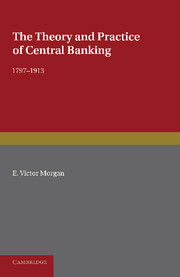Book contents
- Frontmatter
- Contents
- Tables
- Editorial Preface
- Author's Preface
- Chapter I Banks and Banking in the Early Nineteenth Century
- Chapter II The Bank Restriction Period, 1797–1821
- Chapter III Monetary Theory of the Bank Restriction Period
- Chapter IV The First Years of Resumption, the Crisis of 1825, and the Bank Charter Act, 1833
- Chapter V The Horsley Palmer Experiment, and the Bank Charter Act, 1844
- Chapter VI The Currency and Banking Controversy
- Chapter VII The Trial of the Bank Charter Act, 1844-58
- Chapter VIII The Great Boom, 1858-73
- Chapter IX The Great Depression, 1873-96
- Chapter X The Last Years of the Gold Standard, 1897–1913
- Chapter XI Monetary Theory of the Second Half of the Nineteenth Century
- Appendix Changes in Bank rate, 1876-1913, with the Amount of the Reserve of the Banking Department and the “Proportion” on the preceding Wednesday
- Index
Chapter VII - The Trial of the Bank Charter Act, 1844-58
Published online by Cambridge University Press: 05 June 2016
- Frontmatter
- Contents
- Tables
- Editorial Preface
- Author's Preface
- Chapter I Banks and Banking in the Early Nineteenth Century
- Chapter II The Bank Restriction Period, 1797–1821
- Chapter III Monetary Theory of the Bank Restriction Period
- Chapter IV The First Years of Resumption, the Crisis of 1825, and the Bank Charter Act, 1833
- Chapter V The Horsley Palmer Experiment, and the Bank Charter Act, 1844
- Chapter VI The Currency and Banking Controversy
- Chapter VII The Trial of the Bank Charter Act, 1844-58
- Chapter VIII The Great Boom, 1858-73
- Chapter IX The Great Depression, 1873-96
- Chapter X The Last Years of the Gold Standard, 1897–1913
- Chapter XI Monetary Theory of the Second Half of the Nineteenth Century
- Appendix Changes in Bank rate, 1876-1913, with the Amount of the Reserve of the Banking Department and the “Proportion” on the preceding Wednesday
- Index
Summary
CHANGES IN BANK POLICY
Before describing the circumstances which led up to the commercial crisis of 1847 we must consider the changes of policy imputed to the Bank in the years after the passage of the Bank Charter Act. The statement of Peel, which we have already quoted, clearly implies that the Bank should abandon the special duties and responsibilities of a central bank and enter into active competition with the private and joint-stock banks of London. The Bank never adopted such a policy, but it did make a number of changes which were hailed as steps in that direction.
The first change was in the discount policy of the Bank. Palmer had explained that Bank rate should normally be above market rate, and that the Bank should normally invest little of its funds in bills. The great influx of gold almost compelled the directors to add to their earning assets in some way, and they now chose to try to increase their discounts, rather than to buy securities. Morris explained their motives to the Select Committee of 1848, saying:
The practice of buying securities when money was abundant, and the price high, and of selling securities when money was scarce and the price low, caused a loss to the Bank, and inconvenience to the money market, which it was desirable to avoid; it was also considered advantageous that a portion of the Bank's resources should be constantly employed in the discount of bills, and so under control.
This marks a reversal of the policy of the previous fifteen years and a return to the views of Harman, Dorrien and Pole. In accordance with this decision, Bank rate was reduced in August 1844 to 2½%, at a time when Gurneys were charging 2 % for first-class bills. Up to 1844 the Bank had been in the habit of making all discounts at the published rate, though it sometimes altered the usance of bills which it would take. But in October 1844 rates above the published one were charged, and in March 1845 the form of notice was changed and the published rate was announced as a minimum.
- Type
- Chapter
- Information
- The Theory and Practice of Central Banking, 1797–1913 , pp. 143 - 164Publisher: Cambridge University PressPrint publication year: 2013



